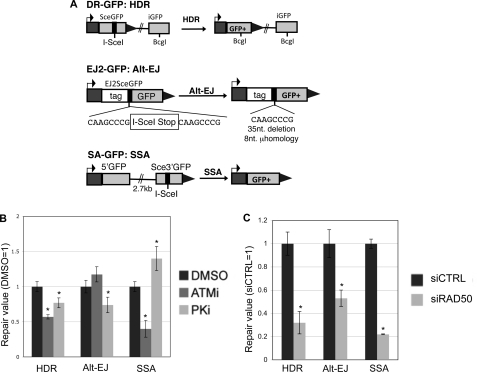FIGURE 3.
The ATM kinase inhibitor, the DNA-PKcs kinase inhibitor, and depletion of RAD50 each have distinct effects on repair events requiring DSB end processing. A, shown are diagrams of I-SceI reporters to examine repair events requiring DSB end processing: HDR (DR-GFP), alt-EJ (EJ2-GFP), and SSA (SA-GFP). Each of these reporters were individually integrated into U2OS cells to generate a panel of reporter cell lines. B, ATMi treatment causes a decrease in HDR and SSA, but not alt-EJ; whereas PKi treatment causes a decrease in HDR and alt-EJ, but an increase in SSA. Each reporter cell line described in A was transfected with I-SceI and treated with ATMi (10 μm), PKi (20 μm), or vehicle (DMSO). Subsequently, the frequency of the GFP+ repair outcome was determined for each cell line by FACS analysis. Shown are these frequencies relative to parallel transfections treated with vehicle. Asterisks denote a statistical difference from DMSO-treated samples (p < 0.0011). C, RAD50 depletion causes a decrease in HDR, alt-EJ, and SSA. RAD50 was depleted in the U2OS cell lines described in A using the siRNA pool described in Fig. 2A, prior to co-transfection of an I-SceI expression vector with the siRNA. Shown are the frequencies of each repair outcome (marked by GFP+) from these experiments, relative to parallel transfections using a nontargeting siRNA (siCTRL). Asterisks denote a statistical difference from siCTRL-treated samples (p < 0.0012).

